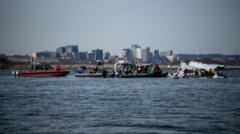During an appearance on FOX News Sunday, Duffy remarked on the necessity for a thorough examination of air traffic operations surrounding the collision of an American Airlines flight and an Army Black Hawk helicopter. The crash claimed the lives of 64 passengers and the three soldiers aboard the helicopter, with no survivors found. Investigators are investigating the timing of the helicopter's flight and its low altitude, which raised questions about whether procedures were followed by the controllers on duty.
Duffy expressed deep concern over the ongoing staffing challenges faced by the Federal Aviation Administration (FAA), highlighting that over 90% of air traffic control facilities are understaffed compared to FAA recommendations. This chronic problem means air traffic controllers are experiencing extreme levels of stress and burnout, complicating their ability to ensure passenger safety.
Following the incident, family members of the victims visited the crash site, united in grief over the preventable loss. As calls for reform intensify, Duffy assures the public that efforts are underway to train more controllers and develop a plan to alleviate the staffing crisis, while users of the airspace continue to demand assurance of their safety during flights.
As investigators piece together the data, the ramifications of this tragedy may spark a necessary reevaluation of aviation safety protocols, focusing not just on aircraft but also on the crucial human element in air traffic management.
Duffy expressed deep concern over the ongoing staffing challenges faced by the Federal Aviation Administration (FAA), highlighting that over 90% of air traffic control facilities are understaffed compared to FAA recommendations. This chronic problem means air traffic controllers are experiencing extreme levels of stress and burnout, complicating their ability to ensure passenger safety.
Following the incident, family members of the victims visited the crash site, united in grief over the preventable loss. As calls for reform intensify, Duffy assures the public that efforts are underway to train more controllers and develop a plan to alleviate the staffing crisis, while users of the airspace continue to demand assurance of their safety during flights.
As investigators piece together the data, the ramifications of this tragedy may spark a necessary reevaluation of aviation safety protocols, focusing not just on aircraft but also on the crucial human element in air traffic management.





















